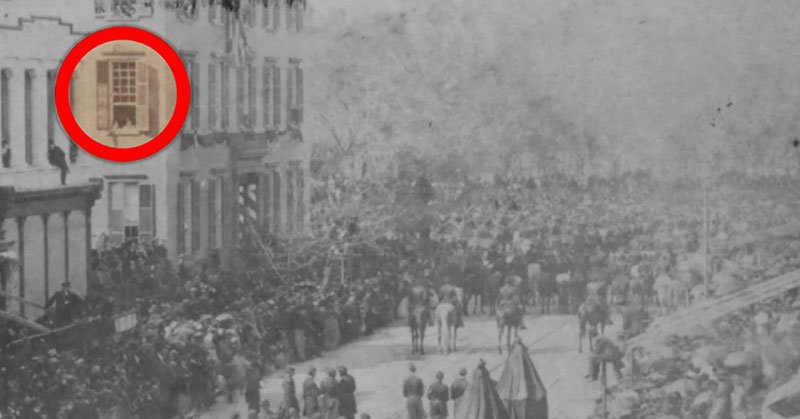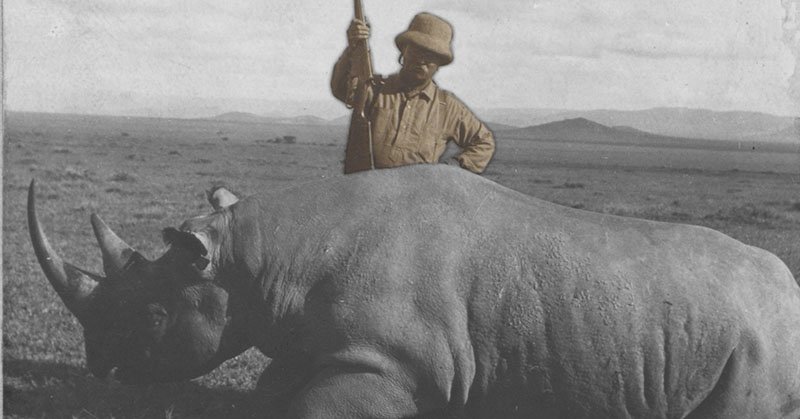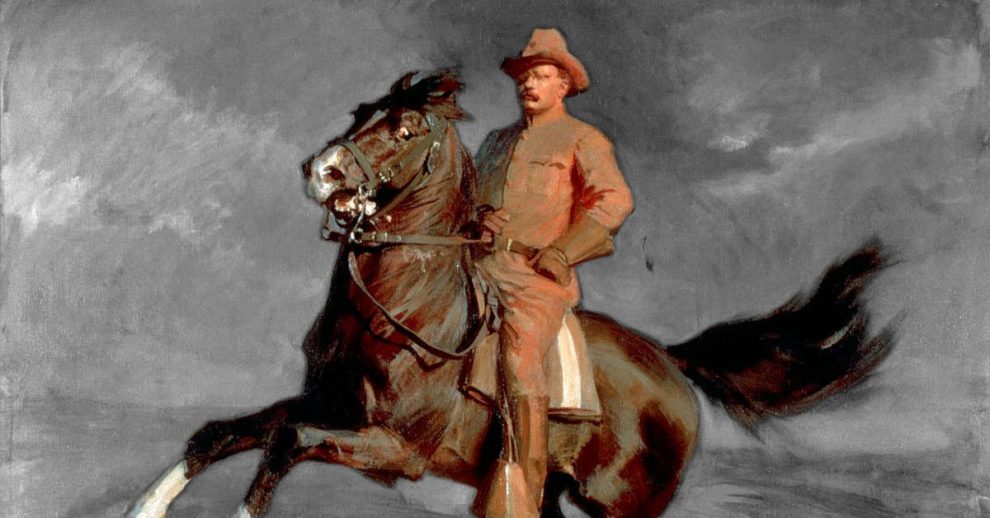Born in 1858 in New York City, Theodore Roosevelt overcame childhood illness to become one of the most dynamic leaders in American history. A scholar, soldier, and statesman, he rose from Harvard graduate to police commissioner, war hero, and eventually the youngest U.S. president after the assassination of William McKinley in 1901. His boundless energy shaped his military exploits, political battles, and personal tragedies, from losing his mother and wife on the same day to raising six spirited children, including his famously rebellious daughter, Alice. Roosevelt’s life burned brightly until his death in 1919 at age 60, leaving behind a legacy of courage, reform, and restless adventure that still defines the American spirit.
Young Roosevelt Watches Lincoln’s Funeral

1. In 1865, young Theodore Roosevelt stood at the window of his family’s New York City home as Abraham Lincoln’s funeral procession passed below. A famous photograph of that somber day captured the boy watching from the window, forever linking him to the moment. The experience inspired Roosevelt’s lifelong admiration for Lincoln. Decades later, Lincoln’s former secretary John Hay gave Roosevelt a ring containing a lock of Lincoln’s hair, which he wore when he took the presidential oath in 1901.
2. One night in the Dakota Territory, Theodore Roosevelt faced down a drunk bully who burst into a bar waving two pistols and threatening to shoot anyone who moved. When the man ordered Roosevelt to buy him a drink, Roosevelt calmly stood and replied, “Well, if I’ve got to, I’ve got to.” Instead of pouring whiskey, he threw a powerful right hook that sent the gunman crashing to the floor. The bully later left the town on a train out of town.
3. In 1880, while studying at Harvard, Theodore Roosevelt wrote his senior thesis, titled The Practicability of Equalizing Men and Women before the Law. In it, he argued that women deserved full legal equality, including property ownership and the right to retain their surnames after marriage.
4. On February 14, 1884, tragedy struck Theodore Roosevelt twice in the same house. His mother, Martha, died of typhoid fever at age 49, and less than twelve hours later, his wife, Alice, succumbed upstairs to kidney failure shortly after giving birth to their daughter. The 26-year-old Roosevelt recorded the moment in his diary with a single, haunting line beside a large X: “The light has gone out of my life.” The double loss shattered him and marked one of the darkest days of his life.
5. During a harsh winter hunting trip in 1886, Theodore Roosevelt discovered that his boat had been stolen by three wanted men trying to flee North Dakota. Refusing to allow them to escape, Theodore Roosevelt and his ranch hands braved freezing temperatures and icy waters to construct a makeshift raft. For three grueling days, they pursued the thieves down the Little Missouri River. Roosevelt finally captured the men himself and turned them in to the nearest sheriff.
6. During the Spanish-American War in 1898, Theodore Roosevelt led his volunteer cavalry unit, the Rough Riders, in their legendary charge up San Juan Heights in Cuba. Despite their name, the men had to fight entirely on foot because their horses were left behind in Florida due to transport shortages. Roosevelt was the only one on horseback, charging ahead under heavy fire. His fearless leadership in that battle made him a national hero and helped propel him toward the presidency.
7. Republican party bosses viewed Governor Theodore Roosevelt’s progressive streak in 1900 as a source of trouble and viewed him as dangerously loud-mouthed. To sideline him, they pushed him onto President William McKinley’s ticket as vice president, a role widely considered a political dead end with little real power. The move backfired when McKinley was assassinated in 1901, and Roosevelt became president.
8. During a 1902 hunting trip in Mississippi, President Theodore Roosevelt refused to shoot a wounded, tied-up bear, calling it unsportsmanlike. The story spread nationwide after a political cartoon depicted the scene, inspiring Brooklyn candy shop owner Morris Michtom to create a stuffed bear he called “Teddy’s bear.” The toy became an instant sensation and forever linked Roosevelt’s name to childhood comfort. Ironically, Roosevelt despised the nickname “Teddy,” insisting that even his closest associates call him Colonel or Theodore instead.
9. In 1902, as winter neared and American homes struggled to get heat, President Theodore Roosevelt faced the Coal Miners Strike. With production stalled and public welfare at risk, he confronted the coal magnates. He threatened to nationalize the coal industry if they refused to accept some of labor’s demands, putting unprecedented federal pressure on the owners during the crisis.
10. In 1903, famed naturalist John Muir “kidnapped” President Theodore Roosevelt from his entourage during a visit to California and led him deep into the wilderness of Yosemite. Over several days of camping under the stars, Muir showed Roosevelt the majesty of America’s untouched landscapes. The experience profoundly moved the president, inspiring him to double the number of national parks and expand federal conservation efforts. As an ardent environmentalist, Roosevelt even banned Christmas trees from the White House to discourage deforestation.
Theodore Roosevelt Adopts a Pet Badger

11. A 12-year-old girl approached Theodore Roosevelt while he was visiting Sharon Springs, Kansas, asking if he would like a badger. Believing she was joking, he consented, only to see her return moments later with a two-week-old cub. Amused and impressed, Roosevelt accepted the animal, naming him Josiah. The feisty badger soon became one of the most unusual and beloved pets ever to live at the White House.
12. While in office, Theodore Roosevelt turned the White House grounds into a small menagerie, housing creatures like a lion, coyote, hyena, black bear, and even a zebra. After leaving office, he embarked on a massive expedition to Africa in 1909, where he and his team killed over 11,400 animals for scientific study. The Smithsonian Institution spent eight years cataloging the vast collection. Roosevelt also funded expeditions to unearth prehistoric fossils, including the successful recovery of a mammoth skeleton.
13. In 1905, after 19 college players died from brutal injuries on the field, President Theodore Roosevelt threatened to outlaw American football altogether. Alarmed by the deaths and mounting public pressure, he summoned representatives from 62 colleges and universities to a meeting in New York City. The group agreed on sweeping reforms to make the game safer, forming the Intercollegiate Athletic Association of the United States, the organization that would later become the NCAA. Roosevelt’s ultimatum transformed football from a deadly brawl into a regulated sport.
14. As New York governor and later as president, Theodore Roosevelt maintained a strict boxing routine to stay fit and test his toughness. One White House sparring session resulted in a blow so severe that he permanently lost sight in his left eye. Ever discreet, Roosevelt kept the injury secret, and his sparring partner didn’t learn the truth until years later through the press. His booming snore was also just as legendary, so loud in fact that when hospitalized, hospitals often gave him an entire floor so others could rest.
15. Theodore Roosevelt objected to placing the phrase “In God We Trust” on U.S. currency, not out of disbelief but out of respect. In 1907, he argued that it was “unwise to cheapen such a motto by use on coins,” believing that invoking God in everyday transactions diminished its sacred meaning. His stance drew criticism from religious leaders, but Roosevelt held firm, insisting faith should be honored through conduct, not coinage.
16. In the early 1900s, white residents in Indianola, Mississippi, threatened Minnie M. Cox, the first African American woman to serve as a postmaster in the United States, demanding her resignation. When she was forced to step down, President Theodore Roosevelt intervened, declaring she had been treated unjustly. Rather than allow her replacement, he ordered the post office to close and continued to pay her salary.
17. In 1906, Theodore Roosevelt became the first sitting U.S. president to travel abroad when he visited Panama to inspect the construction of the Panama Canal. Before this, it was considered improper for presidents to leave the country, as Americans feared their leaders mingling with foreign royalty. Roosevelt’s bold trip broke that taboo, signaling America’s growing global influence. His visit set a new precedent, making international travel an essential part of modern presidential diplomacy.
18. At the White House, a dignitary once complained to President Theodore Roosevelt that his daughter Alice had been smoking on the roof. Roosevelt answered, “I can be President of the United States, or I can control Alice. I cannot possibly do both.” Alice also carried a pet snake named Emily Spinach in her purse and pulled it out around the White House at unexpected moments at guests.
19. In 1906, Theodore Roosevelt became the first American to win a Nobel Prize for brokering peace in the Russo-Japanese War. Nearly a century later, he achieved another distinction when he was posthumously awarded the Medal of Honor in 2001 for his heroism during the Spanish-American War. Roosevelt had originally been nominated for the medal in 1898 after leading the Rough Riders at San Juan Hill. To this day, he remains the only U.S. president to receive both the Nobel Peace Prize and the Medal of Honor.
20. In 1907, the Secret Service bought a White Motor Company steam car in Washington to trail President Theodore Roosevelt’s horse-drawn carriage. Agents used the automobile as a security escort while Roosevelt kept to horseback. He declined to ride in the car, saying it clashed with his image as a rough-riding horseman.
Roosevelt’s Daring First Flight Experience

21. In 1910, Theodore Roosevelt became the first U.S. president to fly in an airplane, taking off from Aviation Field near St. Louis, Missouri. The plane, piloted by Arch Hoxsey of the Wright Company, climbed to about 150 feet during the brief but risky flight. Roosevelt later admitted he nearly fell out of the open cockpit but called it “the bulliest experience of my life.”
22. Among U.S. presidents, Theodore Roosevelt stands out for having a confirmed tattoo. He reportedly wore his family crest on his chest as a tattoo. He remains the only president known to have a tattoo, while Andrew Jackson was only rumored to have a tomahawk on his thigh.
23. In 1912, after losing the Republican nomination to President William Howard Taft, Theodore Roosevelt launched the Progressive Party, quickly nicknamed the Bull Moose Party. He split the Republican vote by running as a third-party candidate against Taft and Democrat Woodrow Wilson. The divided field cleared a path for Wilson, who won the presidency while Roosevelt finished second and Taft trailed far behind. Roosevelt’s defiant campaign reshaped American third-party politics and handed the White House to his rival.
24. In 1912, in Milwaukee, Wisconsin, a saloonkeeper named John Schrank shot Theodore Roosevelt in the chest as he arrived to give a campaign speech. The bullet passed through his steel eyeglass case and a thick, folded manuscript, which slowed it before it lodged in his body. Roosevelt refused treatment and spoke for about 90 minutes, even showing his wound to the crowd and saying, “It takes more than that to kill a Bull Moose.” Only after finishing did doctors examine him and decide to leave the bullet in place.
25. In 1918, Quentin Roosevelt, the youngest son of President Theodore Roosevelt, took to the skies over France as a U.S. Army Air Service pilot in World War I. German aircraft shot him down in aerial combat, and his Nieuport crashed near Chamery. German forces buried him with full military honors. He remains the only child of a U.S. president killed in combat.














Add Comment